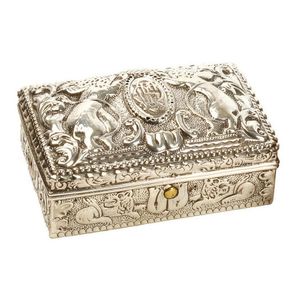Victorian Silver Heraldic Trinket Box with Lions and Crown
You must be a subscriber, and be logged in to view price and dealer details.
Subscribe Now to view actual auction price for this item
When you subscribe, you have the option of setting the currency in which to display prices to $Au, $US, $NZ or Stg.
- Armorial / Armourial - Bearing a coat of arms. Coats of arms came into general use by feudal lords and knights in in the 12th century, and by the 13th century, arms had spread beyond their initial battlefield use to become a flag or emblem for families in the higher social classes of Europe. They were inherited from one generation to the next. When a family crest is used on individual items of silver or furniture it is an indicator of the aristocratic standing of the family represented.
Armorials were also used to decorate mass produced ceramic souvenir ware by such companies as Goss, Carlton & Shelley, and in these cases the coats of arms displayed were of boroughs and cities. - Embossed / Repousse - Embossing, also known as repousse, is the technique of decorating metal with raised designs, by pressing or beating out the design from the reverse side of the object.It is the opposite of chasing, where the decoration is applied from the front. An embossed or repoussed object may have chasing applied to finish off the design.
- Heraldic Decoration - Heraldic decoration on silver, glass, and porcelain refers to the use of coats of arms and other heraldic symbols as decorative motifs on these materials. Coats of arms were traditionally used to identify individuals, families, and institutions, and were often displayed on shields, banners, and other objects.
The heraldic decoration typically takes the form of engraved or etched designs that incorporate coats of arms or other heraldic symbols. Heraldic decoration on silver, glass, and porcelain has a long history, dating back to the medieval period when coats of arms were first used. During the Renaissance and Baroque periods, heraldic decoration on decorative objects became increasingly elaborate and ornate, with finely detailed designs that often incorporated intricate scrollwork, mythological figures, and other decorative motifs.
In the 18th and 19th centuries, heraldic decoration became particularly popular among the aristocracy and upper classes, who used these objects as symbols of their wealth and status. - Cartouche - An ornamental panel in the form of of a shield, oval or rectangular scroll with curling edges. It may be carved into the back of a chair or the top of a sideboard, or present on a piece of silver or jewellery, and contain the initials of the original owner, heraldic symbols, or some other inscription, such as the details of a presentation.
In ceramics the term defines the central area of a vase or similar with a decorative border in one of the shapes above, into which a decorative scene or figures have been painted. - Ebony - Ebony is a close grained timber, black in colour. It has a fine texture which can be polished to a high gloss, making it suitable for venereering, inlay and stringing and its use as solid timber is resticted to small decorative items and ornamental decoration, such as chess pieces and musical instrument parts. The term "ebonised" means "faux ebony", timber that has been darkened during the polishing process to resemble ebony.
- Victorian Period - The Victorian period of furniture and decorative arts design covers the reign of Queen Victoria from 1837 to 1901. There was not one dominant style of furniture in the Victorian period. Designers used and modified many historical styles such as Gothic, Tudor, Elizabethan, English Rococo, Neoclassical and others, although use of some styles, such as English Rococo and Gothic tended to dominate the furniture manufacture of the period.
The Victorian period was preceded by the Regency and William IV periods, and followed by the Edwardian period, named for Edward VII (1841 ? 1910) who was King of the United Kingdom and the British Dominions and Emperor of India for the brief period from 1901 until his death in 1910.
This item has been included into following indexes:
Visually similar items

Russian silver box with enamel detail. 6 x 2.3 x 3.4 cm

Vintage Indian/Ceylonese silver card case, extensive embossed deity decoration in relief, with elephant figure to front. Height 10 cm approx. Weight 122grams

Lidded box. Carved box with tiki face to top with inset paua eyes. Length 12.4 cm. Width 10 cm. D.4.8 cm.

A Burmese red stained box, 19th/20th century, carved with figures and animals, 59 cm width
